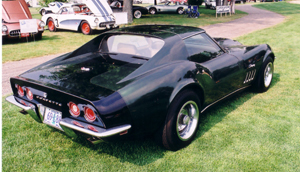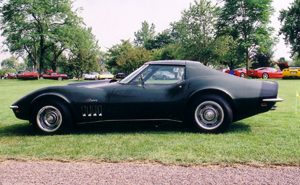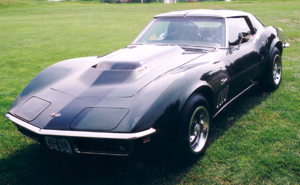 Late in 1967, my boss purchased the first 1968 Corvette sold in the State of New Jersey. It was a white convertible with a tan interior, a black top and a 427-cid big-block V-8. It was good looking, fast and exciting. It was also in the repair shop almost every other week. Chevy hadn’t worked all of the bugs out of the new design.
Late in 1967, my boss purchased the first 1968 Corvette sold in the State of New Jersey. It was a white convertible with a tan interior, a black top and a 427-cid big-block V-8. It was good looking, fast and exciting. It was also in the repair shop almost every other week. Chevy hadn’t worked all of the bugs out of the new design.
The 1969 Corvette continued to feature the “shark” styling introduced in 1968, but it had many improvements. A new grille with black-finished bars replaced a chrome grille. The interior was roomier and the base V-8 was stroked to 3.48 inches to up displacement to 350 cid.
After disappearing in 1968, the sexy Sting Ray name reappeared on the 1969 Corvette. However, it was now spelled as one word — “Stingray.” Badges on the front fenders, above the four slanting air vents, carried the new name badges.
The Corvette’s back-up lights were now integrated into the center of the inner taillights. A steering-column-mounted ignition switch was used and the exterior door buttons used on ‘68 models disappeared in favor of cleaner-looking key-operated locks. There were other small changes like the wheel rims growing from seven inches wide to eight inches to improve the car’s handling characteristics and the steering wheel shrinking from 16 inches to 15. A stiffer frame eliminated shaking.
Inside the car, the interior was a bit roomier. The door panels were mildly redesigned. They now had a thicker upper section and a horizontally-mounted handle. Standard Corvette equipment included four-wheel disc brakes, headlight washers, a central convenience console, wheel trim rings, floor carpeting and all-vinyl upholstery.
The 350-cid V-8 became the base small-block offering this year starting with 300 hp in a mild hydraulic-lifter four-barrel format. RPO L46 was the hotter version with 11.0:1 compression and one hp per cubic inch. Since this was getting into the heavy-duty-muscle era, there were no less than six 427s you could get in the ‘Vette, either as a regular or special option.
The 427-cid 390-hp RPO L36 V-8 was again the starting-point engine for muscle car enthusiasts. Then came RPO L68. It was the same 10.25:1 compressionV-8 fitted with three two-barrel carburetors, which upped its output to 400 hp. The 427-cid 435-hp RPO L71 Tri-Power engine also returned in much the same form as 1968.
Three ultra-high-performance options began with the RPO L88 V-8. Hot Rod tested an L88 and described it as a “street machine with soul.” This year the basic L88 package required heavy-duty brakes and suspension, transistor ignition and positraction. An L88 convertible with a beefy Turbo Hydra-Matic and 3.36:1 rear axle could do the quarter mile in 13.56 seconds at 111.10 mph. 
There was also the RPO L89 V-8. This was a solid-lifter version of the 427 with aluminum heads on the L71 block. It had a 12.0:1 compression ratio and developed 435 hp at 5800 rpm. The L89 produced a hefty 460 foot-pounds of torque at 4000 rpm.
Also available in 1969 was a 427 that was possibly the wildest performance muscle engine ever offered to the public until recent times. This RPO ZL1 all-aluminum big-block V-8 was installed in 69 Camaros and only two production Corvettes. About 10-12 Corvette engineering test "mules" were also built with ZL1s. They were used in magazines, engineering tests and track evaluations and driven by the likes of Zora Arkus-Duntov and GM VIPs. The evaluation vehicles were all destroyed. However, two ‘Vettes went out the door as ZL1s — a Canary Yellow car with side pipes and a Can-Am white T-top coupe with black ZL1 side stripes.
ZL1 was technically an optional version of the L88 engine, but it was some option with its thicker walls and main webbing and dry-sump lubrication provisions. The bottom end had four-bolt main bearings, a forged-steel crank, rods with 7/16-inch bolts, Spiralock washers and full floating pins. The pistons had a higher dome than the L88 type and boosted compression to 12.5:1. The cylinder heads were also aluminum and featured open combustion chambers, round exhaust ports and 2.19-inch/1.88-inch valves. The aluminum dual plane intake was topped by an 850-cfm Holley “double-pumper” four-barrel carburetor featuring mechanical secondaries. The ZL1’s radical solid-lifter camshaft allowed the engine to stay together in the upper revs range.
Car Life magazine wrote, “Corvettes are for driving, by drivers . . . The Corvette driver will be tired of smiling long before he’s tired of the car.” Corvette buyers backed that view by ordering 38,762 cars. That was over 10,000 more cars than they had purchased in 1968
 The car shown with this issue’s profile is a 1969 Corvette coupe with removable roof panels and the L88 engine. This dark green car, wearing Oregon license plates, was on display at Bloomington Gold in St. Charles, Illinois in June 2007. It was one good-looking machine and makes you appreciate the undulating lines of the shark-bodied Corvette.
The car shown with this issue’s profile is a 1969 Corvette coupe with removable roof panels and the L88 engine. This dark green car, wearing Oregon license plates, was on display at Bloomington Gold in St. Charles, Illinois in June 2007. It was one good-looking machine and makes you appreciate the undulating lines of the shark-bodied Corvette.
’69 VETTE FACTS
|
|
|
VEHICLE IDENTIFICATION NUMBER
|
Corvette convertibles for 1969 were numbered 194679S100001 to 194679S138762. Corvette coupes for 1969 were numbered 194379S100001 to 194379S138762. The first symbol 1 indicated Chevrolet. The second and third symbols identify the body series 94 = Corvette. The fourth and fifth symbols indicate the body style number 67 = convertible; 37 = coupe. The sixth symbol indicates the model year 9 = 1969. The seventh symbol identifies the assembly plant S = St. Louis. The last six symbols indicate the sequential production number.
|
|
STANDARD ENGINE
ENGINE OPTIONS
|
Type: V-8
Bore and stroke: 4.00 x 3.48 in.
Displacement: 350 cid
Brake hp: 300 at 4800 rpm.
Induction: Rochester 4-barrel.
Type: V-8:
350-cid/350-hp w/ Rochester 4-bbl. carb
427-cid/390-hp w/ Holley 4-bbl. carb
427-cid/400-hp w/ three Holley 2-bbl
427-cid/435-hp w/ three Holley 2-bbl
427-cid/560-hp w/ Holley 4-bbl. carb
427-cid/435-hp w/ Holley 4-bbl. carb
427-cid/430-hp w/ Holley 4-bbl. carb (*)
(*) Actually over 560 hp
|
|
VITAL STATS
|
Convertible
Original Price: $4,420
Production: 16,633
Wheelbase: 98 in.
Length: 182.5 in.
Tires: F70 x 15
Coupe
Original Price: $4,763
Production: 22,129
Wheelbase: 98 in.
Length: 182.5 in.
Tires: F70 x 15
|
|
COOL STUFF
|
• A side-mount exhaust system was again made optional and sold for $147.45.
• The quality control on 1969 models was somewhat improved from 1968.
• The Mako Shark II Corvette dream car became the Manta Ray. It had a ZL-1.
• The Astro III was a two-passenger show car with a tricycle wheel arrangement. It was designed for gas turbine power.
• Bill Mitchell customized two ’69 Vettes to his personal taste. The Sirocco had a periscope on the roof and a ZL-1. The Aero Coupe had unique spoilers, cast alloy wheels and special side exhausts.
|